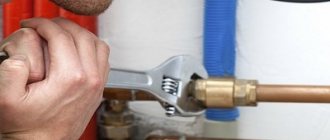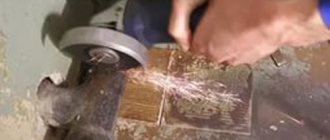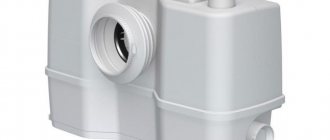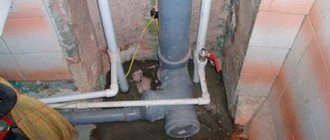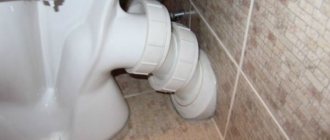As a rule, the decision to replace a sewer riser in a separate apartment is made only in rare cases when the old riser in the toilet has leaked, rusted, or it is necessary to lower the level of the horizontal pipeline. Changing a toilet riser on your own without the proper skills is quite difficult, but possible.
To change the water riser, it is better to contact a specialist, but if you are confident in your abilities, you can do it yourself.
When is sewer repair necessary?
Sewerage is a system of pipelines connected to plumbing and household appliances. The purpose of this design is to drain wastewater from the premises. If the system is mishandled or worn out, malfunctions occur and repairs are required.
Common problems and reasons for their occurrence
Most often, residents are faced with the problem of clogged drains. There are 2 reasons why this happens:
- When installing the pipeline, the builders violated the technology, which led to the formation of stagnant areas. In a private house, due to improper design of the system, the system freezes and an ice plug interferes with the outflow of water.
- During operation, the sewage system was used incorrectly and preventative cleaning was not carried out. Animal fat, hair, and food waste enter the system and form impenetrable plugs at the turning points of the pipes.
Another problem is the natural wear and tear of the pipeline. Constant loads lead to leaks, cracks, and the formation of fistulas, and this cannot be done without repairs.
Design features
The sewer riser is a sequence of pipes and tees.
The system is non-pressure, that is, it does not have excess pressure inside, so all its elements are connected in the simplest way - bell-shaped: at the beginning of each subsequent part there is an extension (this is the bell), into which the previous part is inserted.
In cast iron pipelines, the joints were filled with tow and filled with cement mortar for sealing purposes. Tees are located on each floor near the floor and are used to connect horizontal wiring to the riser.
The part of the riser located above the tie-in on the top floor and extending out through the roof is called a fan pipe. It provides communication between the sewer system and the atmosphere (ventilation), due to which, when a large amount of water moves through the pipes, a strong vacuum does not form in them.
If the drain pipe becomes clogged or is dismantled, each time the toilet tank is emptied, water, like the piston of a vacuum pump, will suck out the water plug from the water seals of plumbing fixtures (this phenomenon is called water seal failure). An unpleasant smell will “float” throughout the apartment.
If you are faced with the problem of failure, replace conventional U-shaped siphons with bottle siphons: when rarefied, they simply draw in air (the process is reminiscent of smoking a hookah).
Although this is not allowed by regulations, some residents willfully dismantle the drain pipe and replace it with an air valve. In this case, you need to select a valve with the largest possible throughput.
What is required for repair
The set of tools and consumables depends on the type of problem and the material from which the sewer pipeline is made. I recommend having everything you need because you never know what kind of emergency will happen.
Tools:
- hammer;
- chisel;
- Bulgarian;
- Screwdriver Set;
- pipe cutter;
- drill;
- cable with a brush.
Consumables:
- clamps;
- couplings;
- sealant;
- cement;
- rubber compressor;
- chemical solvents.
If you need to replace part of the pipeline or riser during repairs, you will additionally need a pipe made of cast iron or PVC.
Preparing for work
Before starting work, you need to make sure that all the necessary tools and materials are available. Here's what we need:
- pipe cutter (can be replaced with a grinder);
- perforator;
- chisel (can be replaced with a chisel) and hammer;
- a strong screwdriver, as well as a nail puller or crowbar;
- safety glasses, gloves and respirator.
Instead of cast iron, when constructing internal sewer systems, today they use a more convenient and durable material - plastic. Therefore, you need to acquire:
- pipe and tee made of PVC or polypropylene;
- pipes (with seals) for connecting plastic pipes to cast iron pipes;
- brackets for attaching the riser to the wall;
If necessary, get an inspection and 45-degree bends (allow you to move the pipe slightly).
Basic methods of do-it-yourself sewer repair
Common problems with the water drainage system in an apartment are blockages and leaks. Depending on the material from which the sewer system is made, a method for troubleshooting is selected.
Blockage
There are 4 ways to deal with blockages. I had the opportunity to use all 4 in practice, each copes with the task in its own way. The main thing is to correctly correlate the cleaning method and the scale of the blockage.
If your toilet or sink is draining slowly, it is wise to use the following methods. Perhaps repairs can be avoided:
- Everyone has a rubber plunger in their apartment. If used correctly, it will clear the clog quickly. Press the rubber tip firmly against the drain hole. There should be water in the sink or toilet at this moment. Perform 15–20 sharp pressures from bottom to top, making sure that the tip is firmly held on the earthenware. Then forcefully remove the plunger. The waste will rise to the surface.
- Cool boiling water will help remove fat deposits. Pour boiling water into the drain, wait 20 minutes and drain the water.
If the water does not go away, but rises up with the waste, use one of the following options:
- An effective method is chemicals to remove blockages. I used the drug "Mole", and I am pleased with the result. Other advertised products, such as "Mr. Muscle" or "Tiret", are also effective. You can pour a mixture of salt and soda into the hole, pour a glass of 70% vinegar essence, then rinse with water 2-3 times. This method will help with minor blockages. Caustic soda removes deposits on pipe walls, but this substance cannot be used for a cast iron system.
- Purchase a cable with an end from a home hardware store. The principle of operation is to twist the cable in the sewer pipe. At the same time, the brush at the end cleans the walls of plaque. While scrolling, you need to drain the water from the tank several times.
The cause of a clogged sink is the accumulation of debris in the siphon. This cannot even be called a repair: you need to unscrew the lower part of the siphon and the drain pipe, remove waste, rinse and put everything back together.
Leak
An unpleasant smell in the apartment is the first sign of a sewer leak. First you need to understand which area is leaking and promptly begin repairs. The main places are connections and joints. Leakage in these areas occurs from improper operation, installation errors and as a result of expiration of service life.
When an old cast iron pipe leaks, the entire sewer system or just the damaged area is replaced. If such repairs are beyond your means, there are other ways to fix the leak:
- process joints;
- repair a fistula or crack;
- remove the blockage.
If the leak has formed in a place hidden by the floor slab, you will not be able to repair such a defect yourself.
Leaking pipes at joints
Before starting repairs, you need to warn your neighbors and ask them not to use the sewer temporarily. Clean the leak area and dry with a hairdryer. Coat with cement mortar with the addition of PVA construction adhesive. The coating dries within 24 hours. During this time, secure the leak site with a repair coupling.
Crack in cast iron and plastic pipe
For pipes made of cast iron and steel, the following methods for eliminating leaks are suitable:
- Treatment with epoxy resin or construction water-repellent adhesive.
- Wrapping with a rubber gasket and fastening with clamps.
- A bandage made of absorbent material and further impregnated with epoxy resin.
For PVC pipes use:
- cold welding;
- self-adhesive tape;
- rubber or silicone sealant.
Replacing old fittings with new ones will help completely eliminate the leak.
Clogged sewer system
If sewerage is installed incorrectly in private homes, water supply pipes freeze. If a blockage has formed at this time, then under the influence of cold the blockage expands and puts pressure on the walls of the pipeline. As a result, cracks appear on the surface. The same situation is typical for apartments in Khrushchev-era buildings. For small defects, it is enough to coat the cracks with sealant.
Repairing cracks in sewer pipes
Every day the sewer riser experiences loads and pressure. The comfort of residents on all floors depends on the serviceability of this pipe in the apartment. If the riser was installed many years ago, repairs in case of severe deformation will help little; it is better to replace the damaged area completely.
For temporary fixation it will help:
- wrapping with plumbing flax;
- coating with a mixture of orthophosphoric acid and copper oxide in a ratio of 2:3;
- sealing with a solution of powdered ammonia, iron filings and sulfur.
Plumbing stores have a large selection of rubberized clamps with a metal frame and various diameters. Installing this will permanently eliminate a crack in a riser made of steel, cast iron or PVC.
How to connect new and old pipes?
Sewerage in an apartment building is a common system: the riser is installed to the entire height of the building, passing through all floors. Therefore, before starting work on replacing pipes, it is necessary to coordinate your actions with your neighbors above and below, because they will have to endure temporary inconveniences associated with water being turned off and the inability to use plumbing in their home.
Ideally, sewer pipes should be replaced simultaneously along the entire length of the riser, but in practice this usually never happens. Some of the neighbors may be against it for financial reasons, others do not want to once again clean up the mess after repair work.
If the neighbors above and below have not agreed to replace the riser, you will have to cut off the old pipe only in your apartment, leaving two fragments of the old pipe protruding from the floor and ceiling. A new riser made of polypropylene pipe will need to be connected to it.
When purchasing shaped products that differ in diameter from the old pipe, you must use a special adapter - a compensator. This product is in the form of a pipe having a narrowing and widening at opposite ends. It is put on the old pipe with the side that corresponds to the diameter. A new pipe is inserted into it, thereby compensating for the difference between the cross-sectional sizes.
Attention! When installing a new riser, rubber cuffs, seals and seals must be used to ensure the tightness of the joint.
How to replace a sewer pipe in an apartment
When completely worn out, the damaged area must be replaced. The services of a road repair specialist, but you can install a new section yourself. If the damaged area is located under a tile or decorative panel, then opening it is necessary. Consider this as an additional cost when repairing the pipeline.
Stages of dismantling an old pipe
Before starting repairs, you need to dismantle the old pipe, turn off the water and disconnect the plumbing fixtures from the sewer. Then do the following:
- If necessary, break the cement screed and free the pipe.
- Disconnect fittings.
- Using a grinder or pipe cutter, cut off the pipe, moving 5–10 cm away from the installation site.
- Remove the sawn part with a hammer and crowbar.
- Fill potholes and uneven areas with cement mortar.
When dismantling, the main rule is not to rush, otherwise there is a risk of damaging entire parts.
Stages of assembling a new pipeline
When replacing an old cast iron sewer system with PVC, first assemble the fittings and pipes into one system. Then marks are made on the walls, taking into account the slight slope towards the riser. Clamps are attached to the marks. After this, the installation of a new pipeline begins:
- Connect the assembled system to the sewerage inlet using a sealing collar. Make sure that no burrs appear in the cutting areas, otherwise this will cause permanent blockages.
- To connect to the plumbing equipment, the pipeline is extended to the required length.
- The tightness at the joints is checked.
Now you can use the new sewage system.
Replacing the riser
Replacing a sewer riser in an apartment with your own hands is done starting from the top. The diameter of the cast iron riser is 100 mm. You need to purchase special rubber cuffs that are placed on the upper section of the pipe and inserted into the lower tee. A plastic adapter is placed on top of the cuff, previously coated on the inside with silicone sealant. It is necessary to ensure the tightness and immobility of the connection in this place so that the plastic does not expand due to warm water and form a leak.
A tee is installed below, from which a horizontal outlet will be assembled. A pipe is led upward from it, onto which a coupling is put on. After aligning the axes of the upper adapter and this pipe, the coupling is pulled upward, connecting both elements into a single system.
After assembling the horizontal part, the tightness is checked by passing a certain amount of water and observing all connections. If there are no wet spots or puddles on the floor, replacing the sewer system in the apartment with your own hands is considered successfully completed. If the work is done correctly, the system will function reliably and without failure for a long time.
Features of repair of external sewerage
The difference between the sewer system of a house in the private sector is that it runs underground. If you need to replace part of the pipeline, you can do without dismantling. To do this, a new one of smaller diameter is laid over the old system.
During a major sewer repair, a pipeline with a defect is dug out, and a new system is laid in its place on a slope. Depending on the region of residence, choose a method of protection against freezing:
- laying to a sufficient depth;
- insulation of pipes with insulating materials.
When it is not possible to remove a leaking pipeline, the method of pressing into the ground is used. A new sewer is laid in the vacant space on top of the old sewer.
Basic mistakes when repairing a sewer system
It is possible to identify the cause of a sewer malfunction and repair it only with an understanding of how the system works. You cannot begin repairs without determining the material from which the pipeline is made. Otherwise, there is a risk of flooding your neighbors and creating an emergency that will affect the entire house. Work should be carried out in strict accordance with the technological process, observing the sequence of actions.
When choosing a material for a new sewer system, many try to save money, while the service life depends on it. You need to buy all components for repairs in trusted stores. Quality certificates must be provided for products.
Possible problems and solutions
The first problem that the owner of a plastic riser has to face is the lack of at least some sound insulation.
The noise from water flowing through the pipes is heard so clearly that you involuntarily begin to look for leaks in your own bathroom.
To eliminate this defect, the riser must be equipped with a soundproofing coating. Two options are used:
- Foam shell: inexpensive and quite effective material. Polystyrene foam is rigid, so it can be used with pipes and tees that are perfectly matched to each other. when the riser does not contain bends or curvatures.
- Polyurethane foam mats: more expensive sound insulation, but due to its flexibility it can be used in absolutely all cases. Polyurethane foam is supplied in rolls. After wrapping the pipe, it is fixed with adhesive tape.
You should not use mounting foam or a sleeve made of foamed polyethylene as noise protection. Foam almost does not block sound, and foamed polyethylene is extremely short-lived: after 1.5 - 2 years it can begin to decompose.
Sometimes the noise of a plastic riser is caused by vibrations that are transmitted to it from building structures. The source of vibrations can be, for example, railway transport. In such cases, the riser is isolated from the ceilings with polyurethane foam gaskets, and rubber bands are placed in the clamps that secure the pipes to the walls.
Pipe covered with sound insulation
Some manufacturers offer plastic sewer pipes with a noise-absorbing effect due to the addition of finely ground marble, chalk or limestone. However, you should know that the service life of such pipes is much shorter than that of conventional polymer pipes - 15 - 20 years.
Another common problem is the appearance of a crack in the wall of a pipe or other element. A special glue called “cold welding” is best suited for sealing it. Another “treatment” option is to wrap the damaged area with a cord impregnated with epoxy resin.
